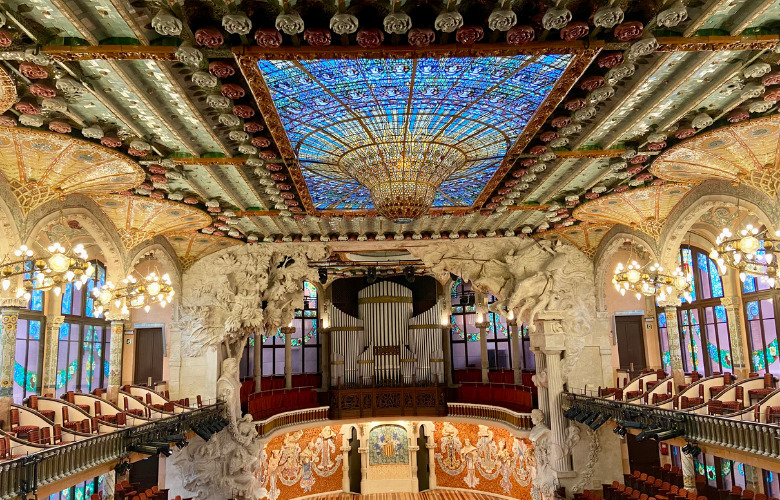
There are many noteworthy entertainment venues around the world. Most of them warranting a simple visit. Even if it doesn’t involve listening to any concerts. One such concert hall extraordinaire is the Palau de la Musica Catalana in Barcelona. And although it is still a fully functioning music hall, it is equally popular as a tourist attraction with guided tours around an interior renowned for its distinctive and ornate style.
Making your way through the rambling and narrow streets of the La Ribera area at the top of El Born in Barcelona, you may stumble across the Palau de la Musica Catalana.
From the outside alone, it is an impressive building with its old and new sections coexisting side by side, in perfect harmony.
Seeing the vivid and playful shapes, colours, and architectural designs outside as well as inside of this magnificent venue makes it easy to understand why the Catalan people take such pride in this building.
They even describe it as a depiction of their soul. A visual representation of their open-minded and forward-thinking spirit.
Designed in the Catalan modernista style by the architect Lluís Domènech i Montaner, the Palau de la Musica was built between 1905 and 1908 for the Orfeó Català.
This was a choral society, founded in 1891. The society was a leading force in the Catalan cultural movement that came to be known as the Renaixença (Catalan Rebirth).
The construction project was mainly financed by Orfeó Català, but important financial contributions also came from Barcelona’s wealthy industrialists and bourgeoisie.
The palace won the architect award from the Barcelona City Council in 1909, given to the best building built during the previous year.
Between 1982 and 1989, the building underwent extensive restoration, remodelling, and extension under the direction of architects Oscar Tusquets and Carles Díaz.
In 1997, the Palau de la Musica Catalana was declared a UNESCO World Heritage Site.
Today, more than half a million people a year attend musical performances in the Palau that range from symphonic and chamber music to jazz and Cançó (Catalan song). Even more people come for the daily tours through the musical palace.
The design of the palace is typical of Catalan modernism in that curves predominate over straight lines, dynamic shapes are preferred over static forms, and rich decoration that emphasizes floral and other organic motifs is used extensively.
The wealthy citizens of Barcelona, who were becoming ever more sympathetic to the Renaixença at the time the palace was built, asked its architect for building materials and techniques that symbolized the Catalan character.
In response, he commissioned and gave great creative freedom to a variety of local artisans and craftsmen to produce the fabulous ornamentation, sculpture, and decorative structural elements for which the palace is famous.
The concert hall of the palace, which seats about 2’200 people, is the only auditorium in Europe that is illuminated during daylight hours entirely by natural light.
The walls on two sides consist primarily of stained-glass panes set in magnificent arches, and overhead is an enormous skylight of stained glass, designed by Antoni Rigalt, whose centrepiece is an inverted dome in shades of gold surrounded by blue that suggests the sun and the sky.
The architectural decoration in the concert hall is a masterpiece of creativity and imagination, yet everything has been carefully considered for its utility in the presentation of music.
The hall is not a theatre, because the massive sculptures flanking the stage make the use of scenery nearly impossible. Likewise, even though a noble pipe organ graces the apse-like area above and behind the stage, the hall is not a church.
Artists like Montserrat Caballé, Ute Lemper, and several famous international conductors who performed on the Palau de la Musica’s impressive stage have all stated how they needed to be extra careful to focus on their performance, since the architectural grandeur all around them left them breathless and distracted.
I must say, I felt the same awe and breathlessness when I recently visited the Palau de la Musica Catalana in Barcelona.
I went on a guided tour which included listening to an ongoing rehearsal of a choir. However, I can’t for the life of me remember what I listened to. So enrapt was I with absorbing the visual feast all around me for the very first time.
Official Website Palau de la Musica Catalan
Wikipedia site of the Palau de la Musica
A Short History of the Zurich Opera House
The House of Dancing Water… Remembering a Masterpiece


Liam Klenk was born in Central Europe and has since lived on four continents. Liam has always been engaged in creative pursuits, ranging from photography and graphic design, to writing short stories and poetry, to working in theatre and shows. In 2016, Liam published his first book and memoir, 'Paralian'.
Read Full Profile© 2021 TheatreArtLife. All rights reserved.

Thank you so much for reading, but you have now reached your free article limit for this month.
Our contributors are currently writing more articles for you to enjoy.
To keep reading, all you have to do is become a subscriber and then you can read unlimited articles anytime.
Your investment will help us continue to ignite connections across the globe in live entertainment and build this community for industry professionals.